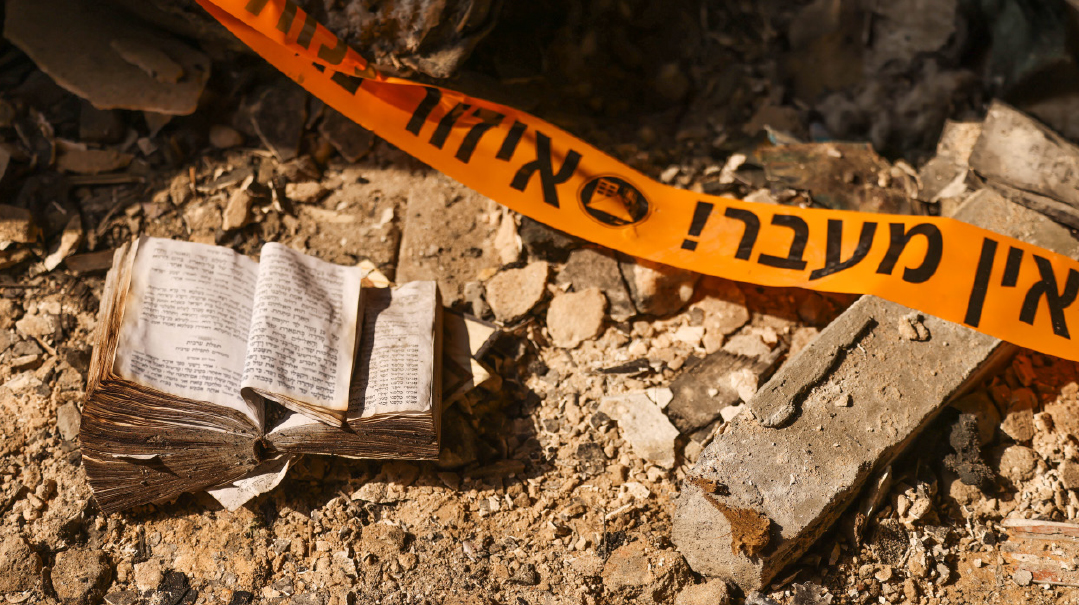A Pogrom on Shemini Atzeres

It is time to do everything we can to restore the social solidarity that has always characterized Israel

MYpost-Succos column, written well before the chag, has been overtaken by the dramatic events of Shemini Atzeres, and I suspect that anything I write today will be similarly overtaken by events before this issue arrives on doorsteps and newsstands.
Already, it is no exaggeration to compare the impact on Israel of Hamas’s Shemini Atzeres invasion from the Gaza Strip to that of 9/11 on America. In terms of casualties so far, the over 800 Israelis known to have been killed exceeds by many multiples the number of Americans killed on 9/11, as a percentage of the population. IDF spokesman Lt. Col. Jonathan Conricus declared it “the worst day in Israel’s history.”
Just as the world changed forever for Americans after 9/11, so too will the world never again be quite the same for Israelis after Hamas’s Shemini Atzeres attacks. Israeli Jews are justly renowned for their resilience, but whatever shreds of our sense of security still remained have now been shattered. The images of Hamas terrorists going methodically house-to-house in Jewish settlements searching for Jews to execute have been seen by every Israeli.
In terms of the magnitude of the IDF’s intelligence and operational failures, Israelis would have to go back to the Yom Kippur War, which broke out almost exactly fifty years to the day (on the secular calendar) prior to yesterday’s attacks — October 6, 1973. Then, the “Concept” that dominated the intelligence echelons dismissed the possibility that the Arab armies would dare attack Israel, in light of their devastating defeat in 1967. But as traumatic as the opening days of the Yom Kippur War were for Israelis, at no point did Syrian and Egyptian forces penetrate within the 1949 armistice lines and massacre Israeli civilians.
This time, it appears that Hamas duped Israel into believing that it cares more about the well-being of Gaza residents, including the 17,000 workers who cross into Israel daily, than about killing Israelis, by refraining from joining Islamic Jihad in recent attacks on Israel.
Today, in Israel, one question dominates all conversation: How could a ragtag Hamas force have overrun IDF forces guarding major crossings from Gaza into Israel, flown over the security fence in motorized paragliders, which transformed into dune buggies, and mounted a third prong of attacks in rubber dinghies from the sea, without having alerted the entire security establishment? Didn’t we all assume that Israeli sensors or overhead surveillance would detect any approach to the security fence kilometers before enemy forces reached the fence? Could it be that Israel became too infatuated with its shiny, high-tech gadgets?
But the intelligence failure was only one of the IDF’s failures. Gazan terrorists rampaged in 22 towns, kibbutzim and moshavim along the border with Gaza for at least five hours, and captured one army base, before the IDF engaged them. They killed over 800 Israelis (by current estimates), mostly civilians, but including dozens of medics, policemen, and soldiers, wounded over 2,100 more, many of them seriously, and captured at least 100 hostages, who were transported back to Gaza. Those hostages will have a dramatic impact on the freedom of IDF forces to act in Gaza, as anyone who remembers the price paid for just one hostage, Gilad Shalit, will immediately recognize. The IDF was still searching for pockets of terrorists a full day later.
AS HORRIFIC as these numbers and images are, the situation facing Israel could become far more grave. Hezbollah has already threatened that it will respond if Israel launches a ground operation into Gaza, which it is almost certain to do.
As Michael Oren, a distinguished military historian and former Israeli ambassador to America, puts it, “What Hamas has done to Israel dwarfs anything they have done before. And Israelis will simply not tolerate a return to the status quo.”
“We will change reality on the ground,” promises Defense Minister Yoav Gallant.
But the price will be, as Prime Minister Netanyahu stated, “unbearably high.” The fighting in Gaza will be house to house, and Hamas has heavily booby-trapped the terrain in which that fighting will take place.
And again, that is before Hezbollah is factored in. Hezbollah has an estimated 150,000 missiles, many of them precision guided, which are located under 200 villages in southern Lebanon. In the 2006 Lebanon War, even a month of heavy Israeli bombing barely made a dent in the number of missiles Hezbollah fired daily. To stop those missiles before they exacted intolerable loss of civilian life in Israel, the Israeli air force would have to obliterate most of southern Lebanon, and quickly, with the inevitable world outcry and condemnation. And Israeli soldiers would likely have to go village by village. The cost to Israel in terms of the loss of civilian life from Hezbollah missiles and the lives of soldiers in the fighting is painful to contemplate.
Moreover, Hezbollah has a well-trained army that would seek to invade Israel. As Maj. General (res.) Yitzchak Brik, who has long warned of Israel’s lack of preparedness for a multifront war, describes the threat, “[Hezbollah] have 10,000 highly trained commandos and fighters, anti-tank missiles, and rockets, Hezbollah is not a guerrilla force. Those fighters intend to cross the Lebanese border into Israel, with vehicles, and motorcycles, on foot and invade settlements in the north — we are not ready for that today.” Indeed, those efforts by Hezbollah forces have already begun.
Nor is Hezbollah the only threat. Hamas will certainly unleash its forces in Judaea and Samaria, and seek support from Israeli Arabs in mixed towns, who are themselves heavily armed, and could put many more Israeli civilians in mortal danger, as they did in 2021. Iranian militias in Syria and Iraq are another source of danger. Not without cause did former national security advisor and chief of IDF planning, Gen. (res.) Giora Eiland label the threat to Israel from a multifront war “existential.”
SUCCESS, IT IS SAID, has many fathers. But, in this case, so does failure, though few will claim parentage. If history is any guide, there will certainly be a government inquiry, as there was after the Yom Kippur War. Prime Minister Golda Meir resigned in the wake of the war, as did many senior military figures.
As the sitting prime minister, it is likely that Binyamin Netanyahu will bear the brunt of the blame for the surprise attack, justly or not. (Unlike Golda Meir, he did not have any warning of threatening, largescale troop movements by Egyptian and Syrian forces.)
Hamas could not have launched such a coordinated attack without the financial backing of Iran, and almost certainly a great deal of Iranian assistance in the execution of the attack. Ninety-five percent of the 5,000 rockets Hamas fired at Israel on Shabbos are manufactured in Iran, and the rest are based on Iranian engineering. According to the Times of London, the assessment of British intelligence is that Iran’s Islamic Revolutionary Guard Corps “have their fingerprints all over these multifaceted attacks.” And the Wall Street Journal reports that the IRGC signed off on the final plans for the attack a week ago Monday.
And here the Biden administration bears a great deal of the responsibility for emboldening Iran. The Biden administration has been termed the third Obama term, and, like its predecessor, has made clear that it will avoid military conflict with Iran at all cost, no matter what the provocation — i.e., menacing US ships, attempting to assassinate former US officials and the Saudi ambassador to the US. on American soil, and Iran’s parliament chanting “Death to America” on repeated occasions.
The Biden foreign policy team is chiefly made up of holdovers from the Obama years, and has bought into the great “realignment” theory that President Obama thought would make him a transformational figure in world diplomatic history. As outlined by Michael Doran in Mosaic in 2015, “America’s Secret Iran Strategy,” and more recently by Doran and Tony Badran in Tablet (“The Realignment,” May 11, 2023), by recognizing Iranian “interests” in Syria and Iraq, and, most importantly, by ensuring that it would one day attain nuclear weapons, Obama believed Iran would be become a regional hegemon and allow for American withdrawal from the Middle East, including its support of Israel. From the first, Obama announced his intention to “put daylight” between the US and Israel. (Incidentally, the American government blandly admitted last week that Iran is only two weeks away from having enough fissile material for a nuclear weapon.)
Obama’s realignment theory will forever stand as a classic example of a theory so stupid that only an intellectual could convince himself of its validity. The idea that Iran would become a status quo power depended on ignoring the theological nature of the regime and refusing to give credence to its theological commitment to the spread of Islam and to the destruction of Israel, whose presence on formerly Muslim-controlled land is a stain on Islam.
Most disastrously, Biden chose Robert Malley as his special envoy to Iran, the same position he had held in the Obama administration. Though Malley has been suspended from his position for security breaches, he succeeded, as John Solomon reported last week in Semafor, based on a tranche of internal Iranian government documents, in pushing close associates, who are dedicated to pushing the case for Iran, including its nuclear program, into senior American positions. Ariane Tabatabai, a second-generation American-Iranian, is, for instance, the chief of staff to the Assistant Secretary of Defense for Special Operations Christopher Maier. She has on several occasions sought guidance from the Iranian foreign ministry as to which conferences she should attend and which not. She was also approved by the Defense Department for a top-secret security clearance, giving her direct access to the most sensitive real-time details of US special forces operations.
Just weeks before the Hamas attacks, President Biden freed $6 billion in frozen Iranian assets for the purchase of medicine and food, which in turn provided Iran with an equivalent amount of foreign currency to finance its terrorist tentacles in Gaza and Lebanon. Money, as they say, is fungible.
Nor were those $6 billion the only monies sent directly or indirectly from the US into Hamas pockets under President Biden. The Trump administration cut off funding to UNWRA and to the Palestinian Authority, under the Taylor Force Act, which prohibits funding of organizations that pay the families of terrorists and “martyrs” — “slay for pay.” And it strictly enforced sanctions on the sale of Iranian oil.
The Biden administration, by contrast, quickly restored all those sources of funding. The Biden State Department applied to the Treasury Department for a waiver to transfer hundreds of millions in funding to the Palestinian Authority, even though is admitted that there was a “high risk that Hamas would directly or indirectly benefit from US assistance to Gaza.” Those transfers, the State Department argued, were necessary to preserving the possibility of a Palestinian state, even though Hamas (as well as the Palestinian Authority) have repeatedly made clear that they have no interest in such a state, only in destroying Israel.
As long as we are speaking of responsibility for emboldening Iran, let us not forget the ten months of weekly demonstrations against the government, which served to highlight the deep divisions in Israeli society. Billionaire Kobe Richter, a close friend of former prime minister Ehud Barak, predicted that by the end of the year, the decline in Israel’s credit rating, leading to higher interest rates, and the eroding security situation would convince working-class Likud voters to abandon Bibi. Well, he and his friends achieved that “eroding security situation” in spades. Just another reminder of the need to be careful about what you wish for.
ALL THE FOREGOING can be found in the vast reportage elsewhere. But one aspect of the attacks has gone largely unnoted, and it is perhaps the most crucial for readers of Mishpacha: the religious dimension. Last Shabbos was both the Torah festival of Shemini Atzeres and the rabbinically ordained celebration of the completion of the Torah, Simchas Torah. The two celebrations do not conflict: They both highlight the unique closeness of Hashem and the Jewish People.
The Midrash compares Shemini Atzeres to a private meal of the King with his beloved son, after all the other guests — the nations of the world — have returned home. And what is the greatest manifestation of that special closeness? The gift of the Torah. Simchas Torah is a day of rejoicing with that great gift: nagilah v’nishmichah bach (We will be glad and rejoice with You, through the 22 letters — gematria bach — which comprise the Torah.)
The events of this Shemini Atzeres did not exactly enhance feelings of Hashem’s special love for us. Rather they seemed a rejection, like rain on Succos. A suggestion perhaps that we have somehow blocked the relationship with Hashem. If there is indeed a reproof, as the Brisker Rav told Rav Amram Blau, citing Yonah, it is first and foremost a reproof to those of us who seek that closeness to Hashem.
But now is not the time to focus on what we have done wrong. Rather it is time to do everything we can to restore the social solidarity that has always characterized Israel. That begins with looking for all that is good in our fellow Jews. Let us think, then, about the incredible bravery of the Israeli troops who will be going house-to-house in Gaza, of the reservists who turned up for duty, with little idea of how long they will be away from their families, or even whether they will ever again see their spouses and children. Let us pray for the terrified captives being held hostage by Hamas, who already know that there is no level of inhumanity to which their captors will not descend.
Amir Tivon, a writer for Ha’aretz, describes how he, his wife, and two young daughters spent the day in their reinforced room on Kibbutz Nachal Oz, while listening to gunfire all around. When he first realized what was happening, he sent a message to his father Noam Tivon, 62, a reserve general, who immediately responded that he was on his way, joined by his wife. On the way to rescue his family, Noam and his wife transported wounded from another kibbutz northward to medical care, before they decided to split up.
Noam continued, while his wife drove to a hospital in Ashkelon. Noam convinced a young soldier in a unit that had lost communication with its commanders to join him, as he headed to Nachal Oz. Along the way, he picked up at least two more reserve generals who had rushed to the scene to do whatever they could, including former deputy chief of staff Yair Golan, a man of the far left. When they arrived in Nachal Oz, they found two elite units searching for Hamas terrorists. Not until late afternoon, when the air was thinning and the light waning in the reinforced room sheltering his son’s family, was Noam finally able to knock on the window, and announce, “Saba is here.”
And let us believe in our fellow Jews and in their determination to hold on to some thread of their Jewish identity. Jerusalem Post columnist Liat Collins wrote after the events of Yom Kippur in central Tel Aviv about a former colleague who had been raised in a religious family. On his first Yom Kippur in Tel Aviv, he got into his car and prepared to drive to the beach. But an older woman, herself fully secular, came over to his car and told him, “In this neighborhood, we do not drive on Yom Kippur.”
About at least one yishuv near Gaza, we can be sure that Shabbos observance will be greatly strengthened after the events of Shemini Atzeres. Prior to Shabbos, the traditional residents decided that they wanted to strengthen Shabbos observance, and they locked the thick metal gate leading into the settlement for the first time on Shabbos. On a video clip I watched, a truckload of Hamas terrorists arrived at the gate but were unable to break through. They gave up after a few minutes and proceeded down the road to the next settlement.
May we be zocheh to see many formerly secular Jews celebrating next Shemini Atzeres their connection with Hashem and His Torah.
(Originally featured in Mishpacha, Issue 981. Yonoson Rosenblum may be contacted directly at rosenblum@mishpacha.com)
Oops! We could not locate your form.







